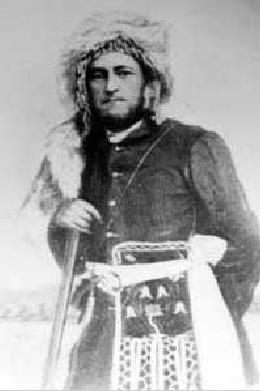In September 1840, Robert Newell, Joseph L. Meek, and their families reach Fort Walla Walla, the Hudson’s Bay Company trading post on the Columbia River in present day Walla Walla County, with three wagons that they have driven laboriously from Fort Hall in Idaho. Newell and Meek, fur trappers from the Rocky Mountains, are on the way to settle with their families in Oregon’s fertile Willamette Valley. Their wagons are the first to reach the Columbia River over land, and they open the final leg of what becomes known as the Oregon Trail to wagon traffic.
Robert Newell, known as "Doctor," and Joseph Meek were free trappers, so called because they were not employees of the large fur trading companies, but worked on their own deep in the Rocky Mountains, trapping beaver and other animals for their furs, which they traded for supplies at yearly rendezvous. Both men married Nez Perce women, and by 1840 they had growing families, and were tiring of the trapping life. They were "anxious to make themselves permanent homes in some more agreeable country where they might find school and other advantages for their children" (Snowden, 24), and by 1840 had chosen the Willamette Valley as their destination.
The Much-dreaded Job
Newell had guided a party of missionaries from the Green River in Wyoming to Fort Hall, a fur trading post located northeast of the present site of Pocatello, Idaho. At that time, Fort Hall was the farthest point on the trail that wagons had reached. The missionaries left their wagons at the fort and continued on horseback to the Columbia River, giving some of the wagons to Newell in payment. Although Newell and Meek knew it would be difficult to get wagons through to the Columbia, they thought it might be more convenient for their wives and children than on horseback, and decided to try. "Doctor" Newell described the journey in a letter written years later:
"At the time I took the wagons, I had no idea of undertaking to bring them into the [Oregon] country. I exchanged fat horses to the missionaries for their animals; and, after they had been gone a month or more for Willamette ... I concluded to hitch up and try the much-dreaded job of taking a wagon to Oregon ... . On the 15th of August, 1840, we put out with three wagons; Joseph L. Meek drove my wagon. In a few days, we began to realize the difficult task before us, and found that the continued crashing of sage under our wagons, which was in many places higher than the mules’ backs, was no joke. Seeing our animals begin to fail, we began to lighten up, finally threw away our wagon beds, and were quite sorry we had undertaken the job. All the consolation we had as that we broke the first sage on the road, and were too proud to eat anything but dried salmon skins after our provisions had become exhausted. In a rather rough and reduced state, we arrived at Dr. [Marcus] Whitman’s [1802-1847] mission station, in the Walla Walla valley, where we were met by that hospitable man, and kindly made welcome, and feasted accordingly. On hearing me regret that I had undertaken to bring the wagons, the Doctor said: ‘Oh, you will never regret it; you have broken the ice and when others see that wagons have passed, they too, will pass and in a few years the valley will be full of our people.’ The Doctor shook me heartily by the hand. Mrs. Whitman, too, welcomed us . . . We spent a day or two with the Doctor and then went to Fort Walla Walla, where we were kindly received by Mr. P. C. Pambrun, chief trader of the Hudson’s Bay Company, and superintendent of that post. On the 1st of October, we took leave of those kind people, leaving our wagons, and taking the river trail . . ." (Snowden, 24-25).
The families finally arrived in the Willamette Valley in December, after swimming their animals several times across the Columbia and Willamette rivers, and surviving for weeks on dried salmon. Both Newell and Meek went on to play roles in organizing the first provisional government of Oregon Territory. And Marcus Whitman’s words to Newell proved prophetic. Many more wagon trains soon followed their tracks, filling the valleys of Oregon and Washington with settlers.

